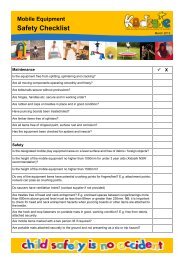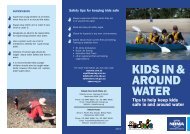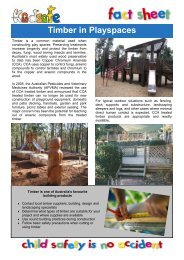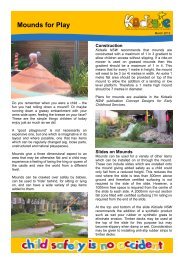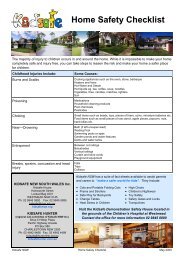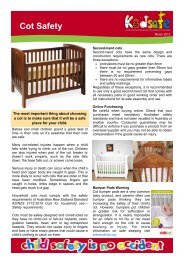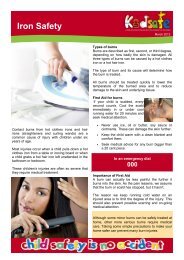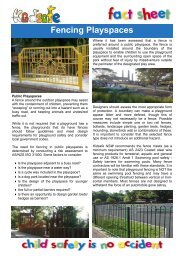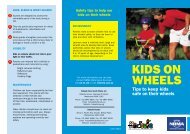NEWS - Kidsafe NSW
NEWS - Kidsafe NSW
NEWS - Kidsafe NSW
Create successful ePaper yourself
Turn your PDF publications into a flip-book with our unique Google optimized e-Paper software.
Six Simple Tips to Maintain Your Pool<br />
As a pool owner you are<br />
responsible for ensuring the<br />
safety of children in your<br />
home and neighbourhood.<br />
Summer is the time when<br />
more people are enjoying their<br />
swimming pools and tragically<br />
this is when more drowning<br />
incidents occur.<br />
One of the main reasons for children drowning in pools<br />
is because of faulty pool fencing. Protect children by<br />
checking the swimming pool fence for faults,<br />
particularly in the months leading up to summer.<br />
The Children‘s Hospital at Westmead recommends you<br />
use the following tips to maintain your pool fence:<br />
Regularly check that the gate self-closes and<br />
self-latches<br />
Regularly check and adjust the latching device as<br />
needed to ensure that they are operating<br />
correctly and have not been affected by the<br />
ground, fence or latch movement.<br />
Regularly check fencing panels for correct gaps,<br />
rust , wear and tear<br />
Regularly check all fence<br />
bolts, screws and fasteners<br />
to make sure they are tight<br />
and in good order. Any<br />
loose bolts, screws and<br />
fasteners should be<br />
tightened or replaced.<br />
Regularly replace springs<br />
and regularly spray self-closing gate hinges, locks<br />
and latches with lubricating oil or silicone to help<br />
prevent many of the faults relating to self-closing<br />
and self-latching gates<br />
Make sure trees, shrubs, BBQ‘s, pot plants, toys,<br />
ladders, chairs and other objects are not within the<br />
90cm non-climbable zone on the fence and are<br />
stored as far away from the fence as possible<br />
For further information about pool fencing, the common<br />
faults and how to check its safety, view the Protect<br />
Your Pool, Protect Your Kids online video or<br />
download the inspection checklist at:<br />
www.kidshealth.chw.edu.au/projects/drowning -<br />
prevention/swimming-pool-fencing<br />
Inflatable Pools Need Fences Too!<br />
Inflatable swimming pools are popular due to their easy set-up and low<br />
cost. There are significant dangers that all pool owners should be aware<br />
of.<br />
Inflatable pools can be more risky than pools that have been built. This<br />
is because most of these pools do not have fences and some are not<br />
able to be emptied after use due to their size. Without fences, children<br />
have easy access to the water in the pool, placing them at increased<br />
risk of drowning.<br />
From 1 July 2009 to 30 June 2010, 33 children under five years of age<br />
drowned in Australia. For every drowning death in <strong>NSW</strong>, a further 4-5<br />
children were hospitalised as a result of near drowning in 2008-09.<br />
Children under five years of age are most at risk of drowning, compared<br />
to all other age groups, with about 50% of drowning deaths occurring in<br />
swimming pools.*<br />
Currently, no Australian data on drowning in inflatable pools exists,<br />
however in America, rates of drowning in inflatable and portable pools<br />
has increased over the years from nine cases in 2004 to 17 cases in<br />
2005 and 21 cases in 2006.<br />
By law, all inflatable or portable swimming pools that are capable of<br />
being filled to 300mm of water or more require a four-sided fence.<br />
Fencing improves the safety of your children and reduce the risk of<br />
drowning.<br />
*For references and more information on safe pool fencing visit<br />
www.kidshealth.chw.edu.au/projects/drowning-prevention/swimming-pool-fencing<br />
Page 4




